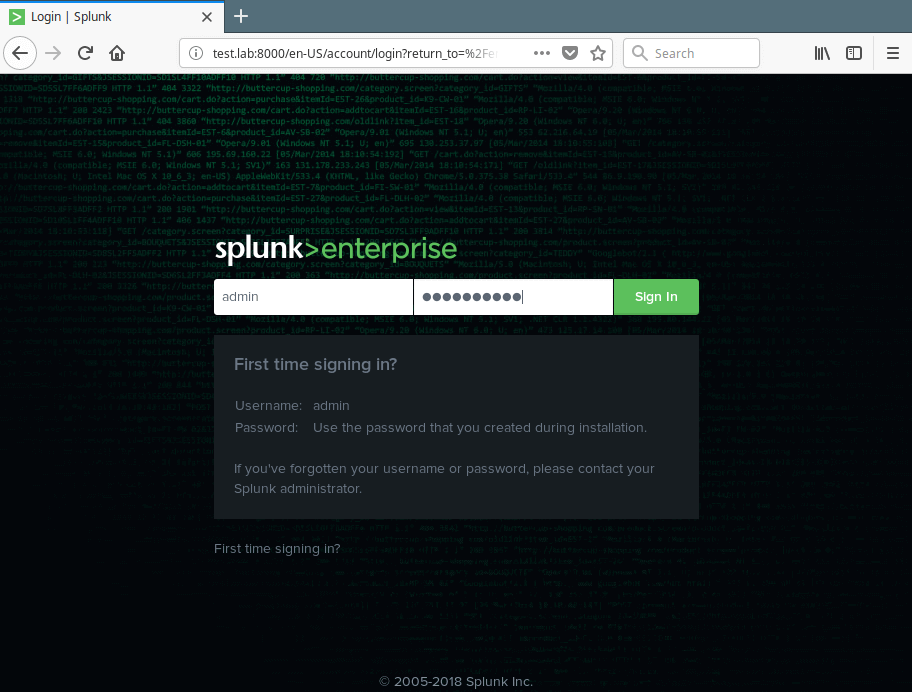

To start, there are four main methods of logging into Splunk for your Connected Experiences app! Although their advantages vary, they are all designed to accomplish the following: So, with this blog, I’d say it’s time to talk about the many login methods users can leverage with their Splunk instance on mobile.
SPLUNK LOGIN HOW TO
The logging feature within Ansible Automation Platform is currently set up to easily work with Splunk, Logstash, Loggly, Sumologic and provides an other option if you’d like to use a different third party external log aggregation service.įor the purposes of this reference environment, the focus is on using Splunk Enterprise 8.2.2 to setup centralized logging across both our Ansible Automation Platform sites.After checking out the Get Started with Connected Experiences blog, you’ll be an expert on 1) how your Splunk data gets to mobile, (2) how to unlock mobile for your Splunk instance, and (3) how user management works. The data is sent in JSON format over a HTTP connection using minimal service-specific tweaks engineered in a custom handler or via an imported library. The types of data that are most useful to automation controller are job fact data, job events/job runs, activity stream data, and log messages. The data can be used to analyze events in the infrastructure, monitor for anomalies, and correlate events from one service with events in another. Services connected to this data feed serve as a useful means in gaining insight into automation controller usage or technical trends. As technology continues to evolve and the enormous amounts of data that many applications capture, logs play a vital role in not only capturing data but to allow for operational intelligence methods to be applied.Īnsible Automation Platform provides a logging feature that allows for the capability to send detailed logs to several kinds of third party external log aggregation services. When we think about logging, the first thought that comes to mind for most is its ability to troubleshoot a particular issue. requirements.yml for automation controller configuration group_vars/all.yml vars file for automation controller configuration (user creation sample)Ĭ.3. Configuring automation controller playbookĬ.2. Working with webhooks"Ĭollapse section "10.4. Configuration consistency across multi Ansible Automation Platform deployments"Įxpand section "10.4. Configuration consistency across multi Ansible Automation Platform deployments"Ĭollapse section "10. Configuration consistency across multi Ansible Automation Platform deploymentsĮxpand section "10. Configuring Ansible Automation Platform automation controllerġ0. Setting up the Splunk HTTP Event Collector (HEC)ĩ.2. Requirements for a High Availability Automation Hub"Ĭollapse section "9. Requirements for a High Availability Automation Hub"Ĭollapse section "7.1. Requirements for a High Availability Automation HubĮxpand section "7.1. Private Automation Hub"Ĭollapse section "7.


Installing Ansible Automation Platform 2.1Įxpand section "7. Configuring firewall settings for execution and hop nodesĦ. Ansible Automation Platform Execution and Hop Node Configuration Details"ĥ.1. Ansible Automation Platform Execution and Hop Node Configuration Details"Ĭollapse section "5. Ansible Automation Platform Execution and Hop Node Configuration DetailsĮxpand section "5. Configuring Controller Database Firewall Settingsĥ. Ansible Automation Platform Controller Database Configuration Details"Ĥ.1. Ansible Automation Platform Controller Database Configuration Details"Ĭollapse section "4. Ansible Automation Platform Controller Database Configuration DetailsĮxpand section "4. Network Configuration"Ĭollapse section "3.1. Ansible Automation Platform Controller Configuration Details"Įxpand section "3.1. Ansible Automation Platform Controller Configuration Details"Ĭollapse section "3. Ansible Automation Platform Controller Configuration DetailsĮxpand section "3. Deploying Ansible Automation Platform 2.1ģ.


 0 kommentar(er)
0 kommentar(er)
